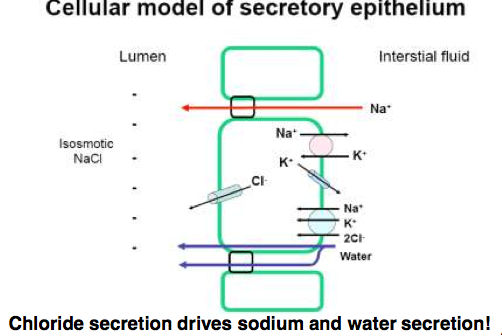Cards In This Set
| Front | Back |
|
Define the properties of epithelia
|
- Connected cells barrier/ compartment
-polarity - different protein expression - different epithelia, different behaviour |
|
What is a tight junction?
|
A junction in the epithelial cell that separates the apical from the basolateral membrane side (cell polarisation).
- It is an important part of the paracellular pathway and constrains/forces the free diffusion of solutes and fluids (claudins) |
|
What is a gap junction?
|
A junction in the epithelia that connects cytoplasmic compartments of cells. It allows the exchange of small molecules between cells (cell communication). In some cases, gap junctions build electrical connections (electrical synapses, heart)
- gap junctions form intercalated discs e.g in the SA node |
|
What are desmosomes?
|
A junction in the epithelia cell that connects cells tightly via cadherins. Cadherins are connected to intermediate filaments that organise intra-cellular filaments (stabilisation). Epithelia exposed to physical stress are often connected via many desmosomes.
|
|
What is an adhering junction?
|
An adhering junction is a junction that provides information about the nature and proximity of cells via cadherins. It is the prerequisite for the epithelial organisation and the apical /basolateral cell polarity. In epithelial tumours, the loss of adhering junction cadherins may be the reason for the metastasis
|
|
What is the apical membrane?
|
Also called luminal or mucosal membrane and faces the lumen of an organ. Their properties are very variable (water permeability). It contains microvilli in highly reabsorptive or secretory epithelial cells. It DOES NOT contain the Na+/K+-ATPase (exclusion: choroid plexus)
|
|
What is the basolateral membrane?
|
It is a membrane that consists of basal membrane and lateral intercellular membrane, also called the serosal membrane. It faces the interstitial fluids. Properties are more similar between different basolateral membranes (high water and K+ permeability). It does not contain microvilli, but membrane infoldings. It expresses the Na+/K+-ATPase.
|
|
Leaky epithelia means:
|
Less number of tight junctions
less selective e.g. in the PCT in the kidneys |
|
Tight epithelia means:
|
High number of tight junctions
Highly selective e.g. in the CCD in kidneys the paracellular pathway is water impermeable |
|
Explain the difference in leaky and tight epithelia, in reference to solute absorption.
|
Paracellular Na+ and H20 absorption
|
|
What are the two types of epithelia and what do they do?
|
Absorptive epithelia (AE) is transport from mucosal(apical) to serosal(basolateral) solution (kidney, intestine). Absorption is driven by active Na+ transport. Leaky AE uses Na+ transport coupled with H+ transport, whereas tight AE uses Na+ apical membrane entry through ENaC. ENaC (Epithelial Na+ channel)
Secretory epithelia provides transport from the serosal (basolateral) to the mucosal (apical) solution. (slivary glands, pancreas, kidney). Here, secretion is driven by active Cl- transport. |
|
What epithelia does salivary glands have? explain
|
Look at slides
|
|
What happens in hydraulic conductivity(water permeability)?
|
Water channels facilitate water movement and they are called: aquaporins. These AQP are expressed in the PCT and the Collecting duct, in the adrenal cortex. There is high water permeability in the PCT and tDLH (AQP1!!). There is almost no water permeability in the ascending limb, DCT and CNT. The only hormone that control water permeablility is in the collecting duct. Vasopressin induces incorporation of AQP 2 so the apical membrane has high water permeability.
|
|
Draw the cellular model of secretory epithelium
|
 Here- |
|
What are the four factors that leaky and tight epithelia could be differentiated by?
|
-apical/basolateral transport proteins
-hydraulic conductivity (water permeability) -responsiveness to hormones -location within organs |



